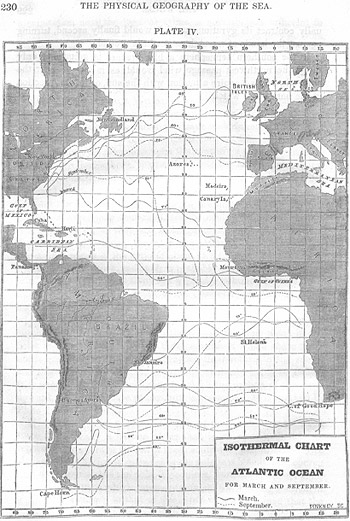The Physical Geography of the Sea, 1st edition
This is a classic work in oceanography by Matthew Fontaine Maury, often called the "father of naval oceanography." In this treatise, Maury sought to educate curious 19th century readers about this new science of the seas by drawing upon the experience of sailors and seamen who enthusiastically shared their knowledge and observations of the ocean.
 Title
page
Title
page
View High-Resolution Image (TIF, 6.1 MB) Page
262
Page
262
View High-Resolution Image (TIF, 608 KB) Page
263
Page
263
View High-Resolution Image (TIF, 644 KB) Page
264
Page
264
View High-Resolution Image (TIF, 648 KB) Page
265
Page
265
View High-Resolution Image (TIF, 636 KB) Page
266
Page
266
View High-Resolution Image (TIF, 644 KB) Page
267
Page
267
View High-Resolution Image (TIF, 640 KB) Page
268
Page
268
View High-Resolution Image (TIF, 628 KB) Page
269
Page
269
View High-Resolution Image (TIF, 640 KB) Plate
10
Plate
10
View High-Resolution Image (TIF, 11.2 MB)
This excerpt includes the title page, pages 262 - 269, and plate 10 from the first edition of The Physical Geography of the Sea.
View the Flash version.Matthew Fontaine Maury is perhaps America's best-known 19th century mariner. He served as superintendent of the U.S. Naval Observatory from 1844 to 1861, where he oversaw research and observation of the Sun, moon, planets, and stars. In 1848, he published the first of the justly famous Wind and Current Charts, based on the observations of winds and currents of the oceans collected from American merchant marine and naval ships' logs. The success of this cooperative venture among seamen inspired Maury to propose an international conference on meteorology in 1853, in Brussels. Soon, a majority of the world's seafaring nations were enthusiastically sending their ships' logs to the U.S. Naval Observatory for inclusion in the Wind and Current Charts.

The equal lines of ocean temperature on this chart (sinuous east-west lines) in Physical Geography of the Sea were generated "by actual observations made indiscriminately all over it" (p. 231). Maury asserted that such information helped to "increase our knowledge concerning the Gulf Stream, for it enables us to mark out,…the 'Milky Way' in the ocean, the waters of which teem, and sparkle, and glow with life and incipient organisms as they run across the Atlantic." (p. 231)
Exploring a New Science
Maury wrote The Physical Geography of the Sea to celebrate this new, collective interest in studying the oceans. This work introduced the new science of oceanography to a 19th century audience awed and fascinated by the mystery and majesty of the world's oceans. He covered subjects ranging from the Gulf Stream, the great ocean currents, whales and whalers, the Northwest Passage, coral reefs, sea salts, ocean climates, hurricanes, deep-sea sounding, and the Atlantic basin.
Eloquent Prose
While not easy for a reader of today, the treatise holds many eloquent passages that evoke Maury's passion for studying the oceans:
"So, too, when one looks out upon the face of this beautiful world, he may admire the lovely scene, but this admiration can never grow into adoration unless he will take the trouble to look behind and study, in some of its details at least, the exquisite system of machinery by which such beautiful results are accomplished. To him who does this, the sea, with its physical geography, becomes as the main spring of a watch; its waters, and its currents, and its salts, and its inhabitants, with their adaptations, as balance-wheels, cogs and pinions, and jewels." (p. 54)
And who could not be drawn to the rich imagery of Maury's compelling prose when he describes the wonders of the sea floor in the following passage:
"Could the waters of the Atlantic be drawn off, so as to expose to view this great sea-gash, which separates continents, and extends from the Arctic to the Antarctic, it would present a scene the most rugged, grand, and imposing. The very ribs of the solid earth, with the foundations of the sea, would be brought to light, and we should have presented to us at one view the empty cradle of the ocean…" (p. 208)
A Seminal Work
While many of Maury's theories advanced in this volume have since been disproved, The Physical Geography of the Sea remains one of the seminal treatises on oceanography. Nine editions of this work have been published, the latest in 1963.
- Author: Matthew Fontaine Maury (1806-1873)
- Date Published: 1855
- Publisher: Harper & Brothers
- Location: New York, New York
- Length: 274 pages
View Complete Rare Book
The Physical Geography of the Sea (pdf, 83 MB)
Related Web Sites
Matthew Fontaine Maury’s Papers at the Virginia Military Institute
Engraving of Matthew Fontaine Maury from the Naval Observatory Library
